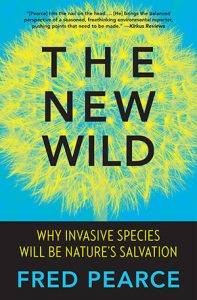The New Wild
Posted in Books: Past and Present on June 13, 2016 by Esther Jackson
Esther Jackson is the Public Services Librarian at NYBG’s LuEsther T. Mertz Library, where she manages Reference and Circulation services and oversees the Plant Information Office. She spends much of her time assisting researchers, providing instruction related to library resources, and collaborating with NYBG staff on various projects related to Garden initiatives and events.
 The New Wild: Why Invasive Species Will Be Nature’s Salvation is the latest book from environmental journalist Fred Pearce.
The New Wild: Why Invasive Species Will Be Nature’s Salvation is the latest book from environmental journalist Fred Pearce.
In recent years, invasive species have been on the minds of many people and have been the focus of a variety of organizations working in ecology and biology, including The New York Botanical Garden. As Science Talk readers may know, the Botanical Garden hosted an invasive species summit in November 2015 to address the threat that invasive species represent to biodiversity worldwide. The summit featured discussion about conservation, including ecosystem management, and involved prominent speakers in the fields of invasion biology, restoration ecology, and not-for-profit land management. The New Wild is quite a topical book.
At first glance, The New Wild seems diametrically opposed to the conservation work that NYBG and others are undertaking, which is without a doubt one of the goals of its inflammatory title and subtitle. Most people who have worked with invasive species management, whether professionally or personally, will have a visceral initial reaction to the philosophy that Pearce seemingly espouses. Still, those who read this book with an open mind might in fact take away some interesting information.
What is Pearce’s goal? From the title, it seems pretty clear: Pearce is here to shake up the accepted norms of conservation ecology. He’s intent on showing readers that not all “aliens” (his so-called non-pejorative term for invasive species) are all bad all the time. What, then, is his hypothesis? Actually, that is less clear. That “aliens” increase biodiversity is one of the ideas that he returns to again and again. That ecosystems are naturally changing and self-regulating is another. That humans are at the bottom of many of the more economically problematic “alien invasions” is a third. There is plenty here for readers to react to and plenty of vagueness for Pearce to conveniently duck behind when making his points.
If it isn’t clear already, The New Wild is not a book with especially good science. Pearce frequently criticizes the lack of scientific data related to management of certain invasive species but then turns around and makes wildly speculative statements of his own without any data to back his claims. As a manipulative tactic, this works exceedingly well. As good writing and good science, however, informed readers will see right through this (at times maddening) stylistic choice.
In the hands of less-informed readers, this book runs the risk of being downright dangerous. Why halt the spread of an invasive species such as Lonicera macckii (bush honeysuckle) when the invaded ecosystem will eventually heal itself? Pearce doesn’t really acknowledge the fact that many ecosystems haven’t “bounced back” from invasive species like bush honeysuckle, nor does he adequately address the fact that the spread of plants such as L. macckii leads to the extirpation of many native species—native plants that will likely never return, even if L. mackii does eventually recede.
All that said, there is definite value to be found in The New Wild once the reader understands that the title is primarily meant to grab attention. As a history of invasive species, it is actually quite enlightening. Pearce writes about the rise of a variety of species such as the zebra mussel (Dreissena polymorpha) to great effect. He also shines a critical light on existing land-management policies and failed restoration attempts. How reasonable is it to restore certain areas? Is there such a thing as a “pristine landscape”? Which species merit aggressive eradication, and which species have been treated with alarmist policies but don’t represent as much of a threat to native biodiversity? These are questions relevant to land managers, ecological researchers, and the public alike, and Pearce does a good job of at least bringing up these ideas.
As a whole, this book is actually worth the read. It’s always good to critically assess one’s beliefs—such as the belief that invasive species put native species and existing ecosystems at risk. That said, land management is not a simple thing, nor should it be treated as such. The real danger of Pearce’s book is that some readers might come away from it with the thought that land management as a whole is unnecessary. This viewpoint is potentially very damaging. In his efforts to make the title and content accessible to readers who have not worked with or studied invasive species, Pearce may actually have done quite a bit of harm.

